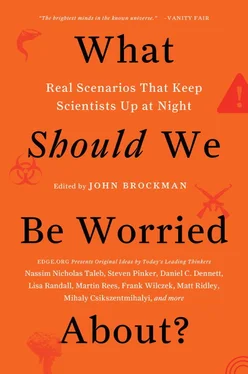Suffering and sadness in many Asian cultures has traditionally been seen as part of a process of spiritual growth and resilience. People in other cultures react to stress differently from us. Even severe illnesses such as schizophrenia may manifest differently outside the U.S., due to cultural adaptations or degrees of social support. For example, a landmark World Health Organization study of 1,379 patients from ten countries showed that two-year outcomes of first-episode schizophrenics were much better for the patients in the poor countries than in the U.S., despite a higher proportion of American patients on medications. In my own travels to India, I have seen these trends in full bloom. As the Asian psyche becomes more Americanized, people from Bombay to Beijing are increasingly turning to pills for stress, insomnia, and depression. Is this the best direction for the entire world to follow?
SOCIAL MEDIA: THE MORE TOGETHER, THE MORE ALONE
MARCEL KINSBOURNE
Pediatric neurologist; neuroscientist; professor of psychology, The New School; coauthor (with Paula J. Kaplan), Children’s Learning and Attention Problems
Mark Twain explained that good intentions lead to good consequences half the time. They lead to bad consequences half the time, also. Were he around today, he would agree that the social media are obviously well intentioned and that their good consequences need no further discussion. However, Twain would realize that he left out an even more common outcome of good intentions: good and bad consequences at the same time. I will discuss what I fear we lose when interaction between people shrinks to a disembodied voice, and worse, a throwaway electronic twittering of words and acronyms.
The sharing of information is the least of what people do when they speak with each other. Far more, speech is a rehearsal of what the listener already knows or has no interest in knowing (technically, phatic speech). Yet people all over the world seek out phatic conversation for its own sake, and research has shown that after a chat, however vacuous, the participants not only feel better but also feel better about each other. How does that come to pass?
Protracted face-to-face interaction is one of the few human behaviors not seen even in rudiment among other animal species. Its evolutionary advantage is as a mechanism for bonding—parent with child, partners with each other. The entrainment into amicable conversation implements the bonding; eye contact, attention to facial expression (smile? smile fading?), and an automatic entrainment of body rhythms, a matching of speech intonation, unconscious mimicry of each other’s postures and gestures, all well documented, which is underwritten by an outpouring of oxytocin. Vigilant anticipation of the other’s body language and continual adjustments of one’s own demeanor in response make for an outcome of a higher order, aptly called “intersubjectivity” or “extended mind.” Minds previously each preoccupied with their own concerns defer to the other’s topic of interest, so as to arrive at a more shared and unified perspective on the object of attention or the topic of debate. Indeed, the harmony goes beyond the concrete and the conceptual. It ranges into the emotions; insistent bleak ruminations diffuse and scatter as the mind mingles with the mind of an intimate or congenial companion.
How to transcend the two-dimensional talking heads staring hopefully from their television perches into the void? Key to the enriched face-to-face communication is that it happens up close and personal, within arm’s length, so that mutual touch is possible. The impoverished response elicited by a posting of good or bad news on Facebook or Twitter—OMG, CUTE!, how cool!, etc.—squanders the opportunity for interpersonal warmth, an embrace, admiring a ring, a diploma, a baby, and the attending reminiscences, the anticipations and sharing of feelings in depth, that happen when two people face each other, lock eye contact, and experience the reality of each other. Evolution notoriously has no foresight, nor is it embodied, but if it were, it would be spinning like a top in its grave as LOL supplants the joy of present laughter. What a waste!
Staples of contemporary interaction have the effect, perhaps intended, of distancing and alienating: the elevated podium, the massive executive desk that separates the speaker and the spoken-to, the dimmed lights as PowerPoint takes over from the human speaker and no one looks at anyone else. As for the written word, text and prose become inert “content,” and the healer is relegated to insurance “provider” status in the mercantile jargon of the day. Then come the online courses, capped by online diplomas, absent any person-to-person teaching. There is no opportunity for the student to participate in an instructor’s inspiration with an excited interpersonal to-and-fro that sharpens the understanding of both parties of the idea at issue. The speaker (writer) and the listener (reader) both face a void. No one is there to talk with.
Humans can do better than that. The entrainment of body rhythms has consolidated the loyalty of, and the shared mindset of, groups perhaps since times prehistoric: the rhythm of synchronous marching feet, the ritual chant, the dance around the cauldron, complete with boiled missionary. Between individuals, the salute—and, adding touch to the multimodal interpersonal mix, the handshake, the high five, couples dancing. Whether the objective is to promote military discipline, adherence to a sect or religious persuasion, or faith-healing, rhythmically entrained behavior is the catalyst and the glue. When the goal is to inculcate irrational and counterintuitive beliefs, this is more successfully done by rhythm and group ritual than by strenuous verbal persuasion. Of such is the collective, otherwise known as the in-group, for better or for worse.
I fear that weakening, if not completely relinquishing, the compelling attraction inherent in entraining both physically and mentally with others will leave people alone even as their tally of “friends” increases. I also fear that the flight from closeness to “individualism” will foster ever more vehement and destructive untrammeled self-expression, as the hobgoblins emerge from the shadows into the spotlight of the Internet and into explosive mayhem in the real world.
DAVID GELERNTER
Computer scientist, Yale University; chief scientist, Mirror Worlds Technologies; author, America-Lite: How Imperial Academia Dismantled our Culture (and Ushered in the Obamacrats)
If we have a million photos, we tend to value each one less than if we had only ten. The Internet forces a general devaluation of the written word—a global deflation in the average word’s value on many axes. As each word tends to get less reading time and attention and be worth less money at the consumer end, it naturally tends to absorb less writing time and editorial attention on the production side. Gradually, as the time invested by the average writer and the average reader in the average sentence falls, society’s ability to communicate in writing decays. And this threat to our ability to read and write is a slow-motion body blow to science, scholarship, the arts—to nearly everything, in fact, that is distinctively human, that muskrats and dolphins can’t do just as well or better.
The Internet’s insatiable demand for words creates global deflation in the value of words. The Internet’s capacity for distributing words near instantly means that—with no lag time between writing and publication, publication and worldwide availability—pressure builds on the writer to produce more. Global deflation in the value of words creates pressure, in turn, to downplay or eliminate editing and self-editing. When I tell my students not to turn in first drafts, I sometimes have to explain, nowadays, what a first draft is.
Читать дальше












